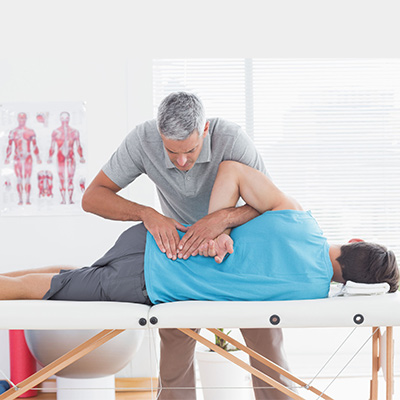Neuromuscular Re-Education
Neuromuscular Therapy is a specific approach to the problem of pain which utilizes advanced concepts in the science and art of pressure therapy.
Treatment
During the initial examination the therapist will note:
- Sensitivity to pain
- Temperature and firmness
- Postural distortion
- State of muscle tone and contraction
A thorough evaluation is made of all trigger points in the general areas of complaint as well as silent trigger points in the common referral zones in order to determine which triggers are contributing factors to tension and pain. Referral to the medical team for trigger point injections may be recommended in order to relax tension and reduce pain in the muscles so that neuromuscular re-education therapy may be applied more efficiently.
-
- The therapist will make a chart of the areas within each painful muscle, ligament and tendon which will require therapy.
-
- Depending on the location of the painful condition, the therapist will use the thumb, hand, elbow, or small soft-tipped pressure bar to manipulate tissue and apply pressure to the involved connective tissue.
- Pressure is usually maintained for approximately six to ten seconds to obtain maximum release.
Specific movement stretches are often provided for developing and maintaining muscle flexibility and normal tone.
Who Is a Candidate?
What Health Problems Have Responded Successfully to Neuromuscular Therapy?
Results
Each Session is Unique, But There are Some Common Post Treatment Questions
- Arm & Hand Pain
- Athletic Injuries
- Back Pain
- Bodily Stiffness
- Bursitis
- Constipation
- Equilibrium Disorders
- Extremity Numbness
- Fatigue
- Headaches
- Hip Pain
- Jaw Pain
- Joint Immobility
- Knee Pain
- Leg & Foot Pain
- Lumbago
- Lowered Vitality
- Muscular Cramping
- Muscular Tension
- Muscular Weakness
- Neck & Shoulder Pain
- Nervous Tension
- Neuritis
- Poor Circulation
- Postural Disorders
- Sciatica
- Shin Splints
- Sinus Disorders
- Spinal Disorders
- Sprains & Strains
- Stiff Neck
- Tendonitis
- Tennis Elbow
- Tortacollis
- Weak Wrists
- Whiplash
- and more….
What can I expect after a treatment?
Neuromuscular therapy allows a reversal of the stress-tension-pain cycle. Pressure specifically interrupts afferent impulses to the spinal cord, reduces the intensity of nervous activity within the tissue and mechanically forces out toxic and lymphatic irritants which have accumulated at nerve receptor sites. The muscle then relaxes, circulation is increased, cellular re-juvenation progresses and the body returns to normal neuromuscular integrity and balance.
It is not uncommon to experience:
- Increased mobility
- Pain reduction or total cessation
- Softening of the nodular spasm at the trigger site
- Increased tissue warmth
- Relaxation of the connective tissue
Does Neuromuscular Therapy hurt?
There is a certain amount of occasional discomfort in any deep muscle therapy. The greatest discomfort is usually experienced after the first treatment. Mild to moderate pressure does not elicit pain in normal healthy tissue. Therefore the presence of pain during the physical manipulation of tissues is a valuable guideline to the therapist. It indicates those areas where adhesions, muscular spasms, trigger points, and cellular toxins are located. Continuous feedback from the patient is encouraged to insure that the therapy is conducted with the minimum degree of pressure necessary to carry out the process successfully and achieve maximum results.
How long does a complete program take?
The initial examination and therapy session lasts one hour. Each succeeding therapy session lasts between 30-60 minutes depending on the number of areas involved. As a rule Neuromuscular Therapy clears the way for rapid results, however healing is a biological process which takes time. The duration of the total therapeutic program depends on:
- How much damage has been done?
- The length of time the condition has existed.
- How rapidly your body heals.
- The state of your general health.
- Those stress factors influencing your life.
The ongoing benefits of therapy are to a certain extent related to you. The cycle has been outlined which relates tension and pain directly to stress.
What is the reason for stretching?
The major purpose of the stress reaction is to prepare the organism for flight or fight. Primitive man met nearly all stress with physical action. Modern man is prepared in the same way for physical exertion in the presence of stress, but has limited socially acceptable ways to respond through physical expression. The implementation of an individually appropriate exercise/stretching program is therefore vital to insure that future stress will not result in the re-occurrence of the tension-pain-cycle.

